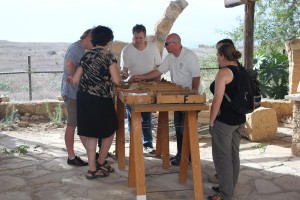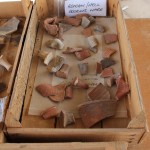Paul’s Pillar at Paphos
October 12th, 2011
On Tuesday, October 11, we went with a group from CAARI to visit several archaeological sites in Nea Paphos on the west side of the island. A group of Australian archaeologists and student assistants are developing one site. we had a guided tour of the site, and later we ate a late lunch with the team.
A lot of archaeology is grunt work. They go to work early in the morning, at first light, in order to beat the heat. In the afternoon, they work in the shade on projects like washing pieces of pottery. A photographer explained to Lynne and me how he takes thousands of photographs of pieces of pottery and other artifacts found at the site. He has a nice setup with his camera on a stand. He places the pottery piece on a glass plate so that there will be no shadow from the flash. He also varies the background color by placing large sheets of paper several feet below the glass. Some editors prefer white background and others prefer blue or reddish when they publish books and articles. Depending on the color of the pottery piece, different background colors enhance the photo.
His camera is directly connected to a laptop computer, so that at soon as he photographs a piece, the photo appears on the computer screen. A program catalogues the information about the sherd. He photographs the same piece from multiple angles. The process is exacting and tedious. I asked the photographer what he does to keep from getting a terribly stiff neck. He told me that he goes swimming in the Mediterranean every afternoon.
At another site nearby, we saw the Panagia Chrysopolitissa Church, which was built in the 13th century over the remains of an earlier church. In the fourth century, a massive church was built on the site, but destruction caused by earthquakes and raids from various outside armies put this church in ruins. Some of the mosaics from the 4th century church are visible in the archaeological remains around the 13th century church.

Church of Panagia Chrysopolitissa. The stubby column fragment on the left, directly in front of the tree, is Paul's Pillar.
A short distance from the church stands the stubby remains of an old column to which, according to legend, the Apostle Paul was tied and beaten for preaching the gospel in Paphos. The story is legendary, and the column dates from a later time. But many Cypriots believe that Paul was tied to that very pillar.
I enjoy watching archaeologists get animated when describing their discoveries and their theories of what they find. Modern archaeology involves the intersection of a number of disciplines, so developing every site involves a lot of collaborative work. In my field, such collaboration is rare. It is a shame, really.
Posted in Uncategorized | 1 Comment »






October 13th, 2011 at 5:05 pm
Painstaking work that demands more patience than this Patience has!
I can hardly wait to talk to you to find out how all this fits together with your own research. I wonder if you have a plan for attacking the material you already have, for what type book will evolve, for what audience. All those things.
See you soon.